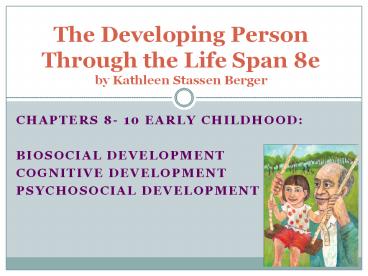Chapters 8- 10 Early Childhood: - PowerPoint PPT Presentation
1 / 19
Title:
Chapters 8- 10 Early Childhood:
Description:
The Developing Person Through the Life Span 8e by Kathleen Stassen Berger CHAPTERS 8- 10 EARLY CHILDHOOD: BIOSOCIAL DEVELOPMENT COGNITIVE DEVELOPMENT – PowerPoint PPT presentation
Number of Views:161
Avg rating:3.0/5.0
Title: Chapters 8- 10 Early Childhood:
1
The Developing Person Through the Life Span 8e
by Kathleen Stassen Berger
- Chapters 8- 10 Early Childhood
- Biosocial Development
- Cognitive Development
- Psychosocial Development
2
Body Changes
- Growth Patterns
- Children become slimmer as the lower body
lengthens. - From age 2 through 6, well-nourished children
grow almost 3 inches and gain about 4 1/2 pounds
annually. - Center of gravity moves from the breastbone down
to the belly button.
3
Body Changes
- Nutrition
- Children need far fewer calories per pound of
body weight than infants do. - Obesity is a more frequent problem than
malnutrition. - Children in low-income families are especially
vulnerable to obesity - cultures still guard
against undernutrition and parents may rely on
fast foods. - Overfeeding is causing an epidemic of illnesses
associated with obesity - Such as heart disease and diabetes
4
Oral Health
- Too much sugar and too little fiber rot the
teeth. - Tooth decay is the most common disease of young
children in developed nations - Affects more than one-third of all children under
age 6 in the United States
5
Just Right
- Some children only eat certain foods, prepared
and presented in a particular way. - Would be pathological in adults but is normal in
children under 6. - 1,500 parents surveyed about their 1- to
6-year-olds - (Evans et al., 1997)
- 75 of the 3-year-olds evidenced some just-right
tendency - preferred to have things done in a certain order
or way - had a strong preference to wear (or not wear)
certain clothes - prepared for bedtime by engaging in a special
activity or routine - had strong preferences for certain foods
6
Brain Development
7
Brain Development
- Speed of Thought
- The primary reason for faster thinking is new and
extensive myelination. - Myelin is a fatty coating on the axons that
speeds signals between neurons. - A gradual increase in myelination makes
5-year-olds much quicker than 3-year-olds, who
are quicker than toddlers.
8
Brain Development
- The corpus callosum, a band of nerve fibers that
connects the left and right sides of the brain,
grows and myelinates rapidly during early
childhood. - Growth of the corpus callosum makes communication
between the two brain hemispheres more efficient. - Lateralization- Literally, sidedness, referring
to the specialization in certain functions by
each side of the brain, with one side dominant
for each activity.
9
Maturation of the Prefrontal Cortex
- From ages 2 to 6, maturation of the prefrontal
cortex has several notable benefits
- sleep becomes more regular
- emotions become more nuanced and responsive
- temper tantrums subside
10
Maturation of the Prefrontal Cortex
- Enables children to
- focus attention and
- curb impulsiveness
Before such maturation
jump from task to task they cannot stay quiet
OR
exhibit perseveration
Marshmallow Test http//www.youtube.com/watch?
vYo4WF3cSd9Q
11
Emotions and the Brain
- Three major areas of the limbic system
- Amygdala- A tiny brain structure
- that registers emotions, particularly fear and
anxiety.
Hippocampus- A brain structure that is a
central processor of memory.
Hypothalamus- A brain area that responds to the
amygdala and the hippocampus to produce hormones
that activate other parts of the brain and body.
12
Improved Motor Skills
- Gross Motor Skills
- By age 6, most North Americans ride tricycles
climb ladders pump their legs on swings and
throw, catch, and kick balls. - Muscle growth, brain maturation, and guided
practice advance every gross motor skill. - Practice improves dexterity and advances fine
motor skills, which involve small body movements.
13
Improved Motor Skills
14
Improved Motor Skills
- Fine Motor Skills
- More difficult to master than gross motor skills
- Many involve two hands and both sides of the
brain
15
Child Maltreatment
- Child maltreatment
- Intentional harm to or avoidable endangerment of
anyone under 18 years of age. - Child abuse
- Deliberate action that is harmful to a childs
physical, emotional, or sexual well-being. - Child neglect
- Failure to meet a childs basic physical,
educational, or emotional needs.
16
Child Maltreatment
- Reported Maltreatment harm or endangerment about
which someone has notified the authorities, up to
3.5 million a year in the U.S. - Substantiated Maltreatment harm or endangerment
that has been reported, investigated and
verified, 1 in 80 children in the U.S.
17
Warning Signs
- Delayed development, slow growth
- Post-traumatic stress disorder child is fearful,
startled by noise, defensive, etc. - Fantasy play around violence and sex
- Repeated injuries, physical complaints
- Hyper vigilance, absences from school
- Fear of caregiver, going home
18
Consequences of Maltreatment
- Severely maltreated children suffer
physiologically, academically, and socially in
every culture. - Maltreated children come to consider other people
to be hostile and exploitative, making them
fearful, aggressive, and lonely. - The earlier abuse starts and the longer it
continues, the worse their peer relationships are.
19
Three Levels of Prevention
- Primary prevention - any measure that reduces
financial stress, family isolation, and unwanted
parenthood. - Secondary prevention - home visits by nurses,
high-quality day care, and preventive social
workall designed to help high-risk families. - Tertiary prevention reduces harm when
maltreatment has already occurred. Requires
permanency planning, an effort to find a
long-term solution to the problem.































